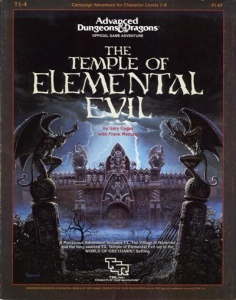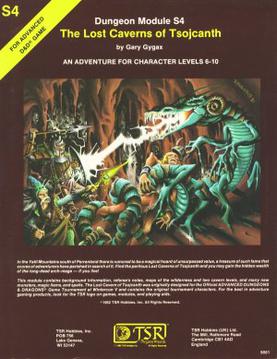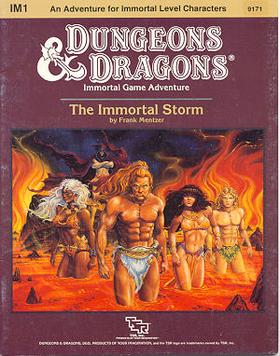
Dungeons & Dragons is a fantasy tabletop role-playing game (RPG) originally created and designed by Gary Gygax and Dave Arneson. The game was first published in 1974 by Tactical Studies Rules, Inc. (TSR). It has been published by Wizards of the Coast, later a subsidiary of Hasbro, since 1997. The game was derived from miniature wargames, with a variation of the 1971 game Chainmail serving as the initial rule system. D&D's publication is commonly recognized as the beginning of modern role-playing games and the role-playing game industry, and also deeply influenced video games, especially the role-playing video game genre.

Mystara is a campaign setting for the Dungeons & Dragons fantasy role playing game. It was the default setting for the "Basic" version of the game throughout the 1980s and 1990s. Most adventures published for the "Basic" edition of D&D take place in "The Known World", a central continent that includes a varied patchwork of both human and non-human realms. The human realms are based on various real-world historical cultures. In addition, unlike other D&D settings, Mystara had ascended immortal beings instead of gods.

The Temple of Elemental Evil is an adventure module for the fantasy role-playing game Dungeons & Dragons, set in the game's World of Greyhawk campaign setting. The module was published by TSR, Inc. in 1985 for the first edition Advanced Dungeons & Dragons rules. It was written by Gary Gygax and Frank Mentzer, and is an expansion of an earlier Gygax module, The Village of Hommlet. The Temple of Elemental Evil is also the title of a related 2001 Thomas M. Reid novel and an Atari computer game.

Dungeonland (EX1) is a 1983 adventure module for the Dungeons & Dragons (D&D) roleplaying game, written by Gary Gygax for use with the First Edition Advanced Dungeons & Dragons (AD&D) rules. It is an adaptation of Lewis Carroll's 1865 novel Alice's Adventures in Wonderland, with the various characters from the book translated into AD&D terms.

Palace of the Silver Princess is an adventure module for the Dungeons & DragonsBasic Set. It was recalled on the same day it was released, then rewritten and re-released some months later. The original version, with an orange cover, was written in 1980 by Jean Wells. When the orange version was recalled, the module was rewritten by Tom Moldvay and released with a green cover. Writing credit on the second version was given to both Moldvay and Wells, although there was very little of Wells' original content in Moldvay's version.

In Search of the Unknown is a module for the Dungeons & Dragons roleplaying game, designed for use with the Basic Set of rules. It was written by game designer Mike Carr and was first published in 1978 by TSR, Inc. The module details a hidden complex known as the Caverns of Quasqueton. Reviewers considered it a good quality introduction to the game that was written in the so-called dungeon crawl style, where the primary goal of the players is the exploration of a dangerous labyrinth to battle monsters and obtain treasure.
Several different editions of the Dungeons & Dragons (D&D) fantasy role-playing game have been produced since 1974. The current publisher of D&D, Wizards of the Coast, produces new materials only for the most current edition of the game. However, many D&D fans continue to play older versions of the game and some third-party companies continue to publish materials compatible with these older editions.

Creature Catalogue is a supplement for Basic Dungeons & Dragons first released in 1986, and updated in 1993.

Isle of the Ape is an adventure module for the Dungeons & Dragons role-playing game World of Greyhawk campaign setting, in which the events occur in a magical demiplane of the same name created by the mad archmage Zagyg Yragerne.

In the Dungeons & Dragons fantasy role-playing game, goblins are a common and fairly weak race of evil humanoid monsters. Goblins are non-human monsters that low-level player characters often face in combat.

Jacob Franklin Mentzer III is an American fantasy author and game designer who worked on early materials for the Dungeons & Dragons (D&D) fantasy role-playing game. He was an employee of TSR, Inc. from 1980 to 1986, spending part of that time as creative advisor to the chairman of the board, Gary Gygax. He also founded the Role-Playing Games Association (RPGA) during his time with TSR.

The Lost Caverns of Tsojcanth is an adventure module for the Dungeons & Dragons fantasy role-playing game. It was written by Gary Gygax and published by TSR in 1982 for the first edition Advanced Dungeons & Dragons (AD&D) rules. The 64-page adventure bears the code "S4" and is set in the Greyhawk campaign setting. It is divided into two parts, a 32-page adventure, and a 32-page booklet of monsters and magic items. The plot involves the player characters investigating rumors of lost treasure. After traversing a wilderness and two levels of dungeons, the players face Drelnza, the vampiric daughter of long-deceased archmage Iggwilv.
The World of Greyhawk Fantasy Game Setting and the World of Greyhawk Fantasy World Setting are two closely related publications from TSR, Inc. that detail the fictional World of Greyhawk campaign setting for the Dungeons & Dragons (D&D) fantasy roleplaying game. Both publications were authored by Gary Gygax, and they were the first stand-alone offerings to provide detailed, comprehensive information regarding a D&D campaign setting.

The Dungeons & Dragons Basic Set is a set of rulebooks for the Dungeons & Dragons (D&D) fantasy role-playing game. First published in 1977, it saw a handful of revisions and reprintings. The first edition was written by J. Eric Holmes based on Gary Gygax and Dave Arneson's original work. Later editions were edited by Tom Moldvay, Frank Mentzer, Troy Denning, and Doug Stewart.

The Dungeons & Dragons Companion Set is an expansion boxed set for the Dungeons & Dragons (D&D) fantasy role-playing game. It was first published in 1984 as an expansion to the Dungeons & Dragons Basic Set.

Dungeons & Dragons Master Rules is an expansion boxed set for the Dungeons & Dragons (D&D) fantasy role-playing game. It was first published in 1985 as an expansion to the Basic Set.

The Expert Set is an expansion boxed set for the Dungeons & Dragons fantasy role-playing game. It was first published in 1981 as an expansion to the Basic Set.

The Immortal Storm is a 1986 adventure module for the Immortals Rules expansion to the Basic Rules of the Dungeons & Dragons fantasy role-playing game.
Oeva Jean Wells Koebernick was an American writer, artist, and editor in the field of role-playing games. She was the first female game designer to be hired by TSR, Inc. Her career at TSR stalled after she wrote a controversial Dungeons & Dragons adventure module that was withdrawn on the eve of publication and subsequently rewritten.
















